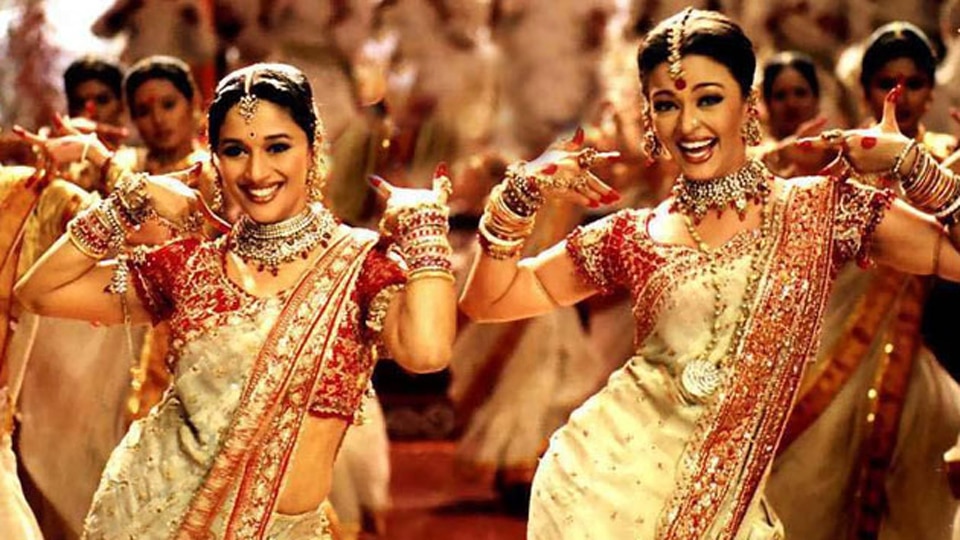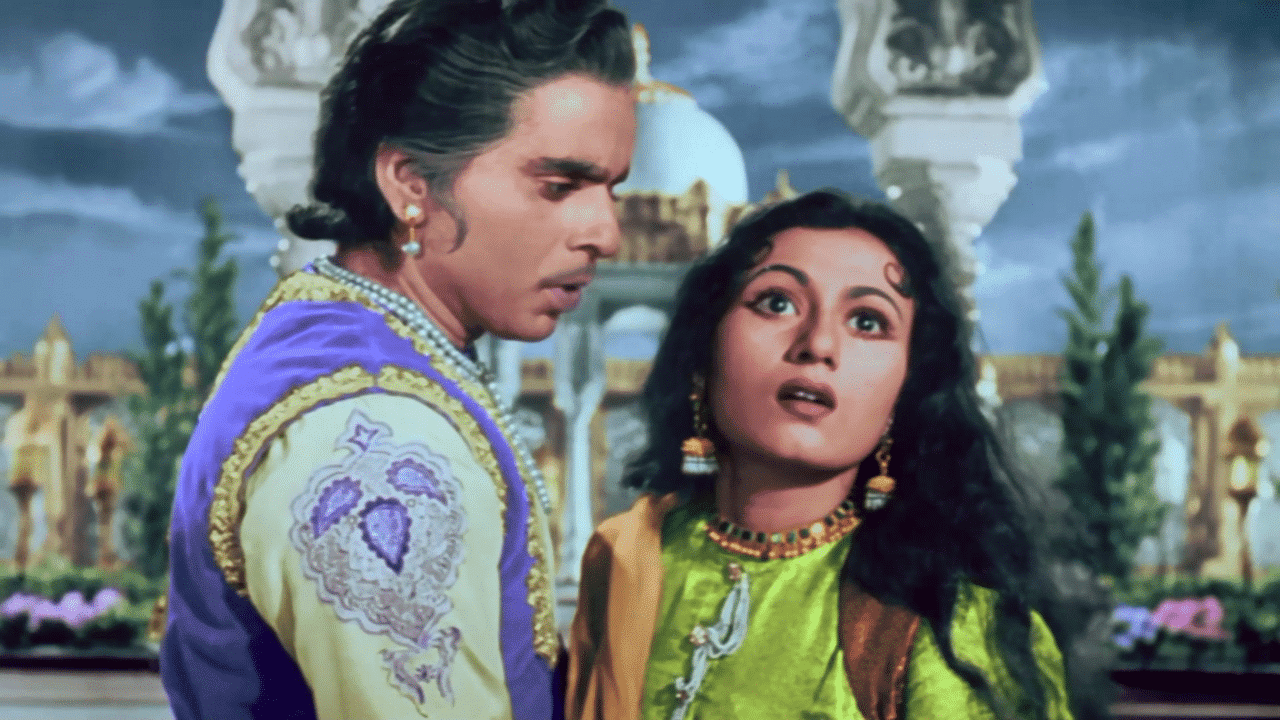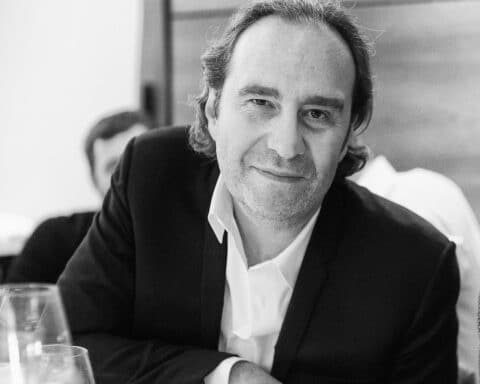The Indian subcontinent is not only home to the world’s most populous state (1.4 billion souls), it is also home to the world’s largest film industry, attracting a fervent following in the country and beyond: that of Bollywood films.
Following on from the Louvre Abu Dhabi, “Bollywood Superstar” is now on show until January 14, 2024, in Paris, at the Musée du Quai Branly, with over 200 works of art, posters, film extracts and stage costumes, all presented in a gaudy, luminescent scenography worthy of the tales of 1001 Nights. The perfect remedy for the winter blues.
Indian Cinema has its roots in shadow theater, magic lanterns and age-old mythological storytelling.

Among the first to discover the Lumière brothers’ cinematograph, the Indians have since developed a booming business around the production of skilfully interpreted and choreographed films.
To the point of surpassing Hollywood production, at a rate of 2,000 films every year. These productions are exported far beyond the borders of the sub-continent, whether via the Indian diaspora – one of the largest in the world – Southeast Asia or the rigorist kingdoms of the Middle East.
Yet this cinema remains largely misunderstood in the West, with Bollywood wrongly equated with all Indian productions. However, this cinema from the former Bombay (now Mumbai) exclusively concerns films shot in Hindustani (a mixture of Urdu and Hindi). Each of the 14 distribution regions has its own cinema with its own linguistic specificities. This cultural and geographical segmentation, with some thirty official languages, makes India a difficult country for any Westerner to penetrate.
Mystical origins
If India is so passionate about cinema, it’s first and foremost because the country was one of the first to welcome the Lumières brothers’ cinematograph.
Indeed, while the first screening of the famous inventor duo took place on December 28, 1895 in the Indian salon of the Café de Paris, the following year their assistant Marius Sestier organized a screening of six of their films at the Watson’s Hotel in Bombay (Mumbai since 1996).
The Indians were particularly receptive to this innovation. A veritable window on the world, the cinematograph offers a clear continuity with their own traditions of live performances and travelling storytellers.
Because it allows us to see “the gods in motion”, the cinema (chalachitra) is a direct descendant of the thousand-year-old stories of the Mahabharata and the Ramayana. Written in the 4th century, they recount the many adventures and exploits of the avatars (from the Sanskrit avatara meaning “descent”) of the supreme god Vishnu, in the form of Rama and Krishna, who come to earth to restore the divine order threatened by demons.
These two stories include three major themes that are inseparable from Bollywood historical films: fantastic battles, romance and spirituality.
The deities present are reminiscent of Bollywood stars elevated to the rank of demigods.
In fact, these legendary stories were the first sources of inspiration for Indian silent cinema in the 1920s, before being dethroned by another source of pride in the country’s history: the glorious and sumptuous Mughal and then Rajput courts.
The Muslim Mughal Empire (1526-1707) – which gave rise to the construction of the Taj Mahal – marked a golden age of prosperity, religious tolerance and the flowering of the arts. It reached its apogee under the reign of the legendary Akbar (1556-1605).

Hindu rulers of the north, the rajputs were transformed into chivalrous warriors united against invaders, wielding swords in the image of the warlike gods of mythology.
Particularly costly, these historical films enjoyed unparalleled success. In any case, Mughal-e-Azam remained the most profitable film in Indian cinema for fifteen years.
Cinema was soon seen as the cornerstone of the Indian nation’s identity-building, as it gained independence in 1947.
Bright, colorful codes
Bollywood cinema reflects the habits and customs of India.
It’s not uncommon, for example, for the plot to include a conflict between modern and traditional India, particularly when it comes to arranged marriages.
Indian cinema contrasts with that of the British occupation, which was particularly elitist and made up of mainly Western productions. Today, the opposite is true: cinema has become a popular art form, and despite the absence of protectionist laws, 95% of cinematographic productions broadcast in the country are Indian.
Its colorful sets and costumes, and the omnipresence of light, recall the traditional festivals of Holi and Diwali respectively – the triumph of light over shadow, of good over evil.
The dances, choreographed to the millimetre, evoke ritual and regional dances, while the heroes’ thwarted loves are reminiscent of the tales told by itinerant storytellers in ancient India.
This is the hallmark of Bollywood films: dance, song and courtly love, where sexuality is always suggested, never shown.
Being an actor in Bollywood also means being able to play the whole range of emotions, including the four primordial ones (rasa) laid down in the 5th century by the treatise on dance: the erotic, the furious, the heroic and the odious.
Although Bollywood films are primarily romantic comedies or dramas, they also mix several genres. A case in point is Sholay (1975), starring Amitabh Bachchan, which blends action, spaghetti western and dramatic comedy.
Moreover, film songs are just as, if not more, important than the film itself. Studios usually release music videos from the film’s soundtrack well in advance of its release, so that every Indian often knows the songs by heart.
For example, Jhoome Jo Pathaan, a song from the film Pathaan directed by Siddharth Anand (2023) starring Shah Rukh Khan and Deepika Padukone, broke the record of one million views, 30 minutes before its theatrical release!
The gradual emergence of superstars
Like its near-neighbor Korea, with its K-pop ecosystem, Bollywood has seen the emergence of real stars who still unleash collective hysteria today.
This rise of the star system coincides with the golden age of Bollywood cinema, between 1940 and 1960.
The quality of staging, images, music, songs and acting, this period gave rise to many masterpieces, before cinema took a more formatted path, with musicals, headliners and big budgets taking precedence.
Producers offered huge fees. No longer tied to a studio, actors and actresses could multiply their commitments. Rumor has it that stars shoot one film in the morning, another in the afternoon, another in the evening.
Rajesh Khanna – who died in 2012 – became Bollywood’s first superstar. Indian women were quick to write passionate letters, sometimes even in their own blood, to this Rudolph Valentino-like Latin lover, who played romantic and vulnerable roles.
Kaka (uncle in Indian), who enjoyed unprecedented success in 1969 with “Aaradhna” (Devotion), was the highest-paid actor in Indian cinema from 1970 to 1987. Starring in 180 films, he scored 17 consecutive hits in three years!
Sridevi – who passed away in 2018 – was the first female superstar, with a filmography that reached its peak in the 1970s and especially the 1980s. She appeared in almost 250 films, in Hindi, Tamil, Telugu and Malayalam.
In the 1970s, Zeenat Aman met her public with Dave Anand’s Hare Krishna Hare Ram (1971), but she burst onto the screen with Yaakon Ki Baaraat (1973), Nasir Hussein’s masterpiece. Her Western look (casual outfits and loose hair) and her hit songs “Dum Maro Dum” and “Churaliya Yeh Tumne Jo Dil Ko” will live long in the memory.
At the same time, Aimtabh Bachchan, also known as Big B, soon became the archetypal angry young man, James Dean style, in films such as Zanjeer (1973), Deewaar (1975), Sholay (1975) and Don (1978).
European audiences were slow to discover the Bollywood film genre. A few did so with the film Lagaan (2001), built around a game of cricket, the national sport since British colonization.
However, it was not until 2002 that Bollywood cinema made its mark on the world box office with Devdas.
Presented at the opening of the Cannes Film Festival that same year, the film also inducted the most international superstar of Indian cinema: Aishwarya Rai Bachchan. Miss World 1994, the actress voted “most beautiful woman in the world”, became the first Indian face of the L’Oréal group. She has since become an ambassador of choice for Indian culture, elevated to the rank of Chevalier de l’Ordre des Arts et des Lettres.
Devdas also introduces Western audiences to another superstar, Shahrukh Khan in the title role, who has been a household name in his homeland since the 1980s.
Known as SRK, he enjoys a variety of nicknames, each more bombastic than the last, such as Bollywood’s Baadshah (Emperor) or King Khan. Together with Kajol, the actor forms one of the most mythical couples in Bollywood cinema. Far from classic romantic comedies, the actress dares to take risks, alternating thriller and comedy.
Since then, the Indian pantheon has grown with stars such as actresses Deepika Padukone, Sonam Kapoor, Priyanka Chopra, Freida Pinto, Athiya Shetty, Manushi Chhillar and actors Karki Kaaryan and Raveer Singh, who are now being snapped up as ambassadors by luxury brands, especially jewelry and beauty brands.
Bollywood, however, is no longer as powerful as it once was. The opulent lifestyle of its artists and its elitist scripts aimed at an urban population are increasingly criticized.
Another South Indian cinema, Tollywood, in the Telugu language, is enjoying growing success. Originating in Hyderabad, these productions represent India in all its cultural and linguistic diversity. 60% of Indians still do not consider Hindi to be their official language.
As a sign of the appeal of this alternative cinema, Shiseido has chosen actress Tamannaah Bhatia, known for her work in Hindi as well as Tamil and Telugu, as its global ambassador.
The Tamil and Telugu-language spy blockbuster RRR (Rise Roar Revolt) has grossed over $175 million, making it one of the highest-grossing films of 2022 and the third-biggest Indian box office success of all time, behind another of the director’s films, The Legend of Baahubali – Part 2.
The film also won the Golden Globe for Best Original Song and the Oscar for Best Original Song for Naatu Naatu.
Read also > WHO IS DEEPIKA PADUKONE, THE BOLLYWOOD SUPERSTAR THAT EVERYONE IS FIGHTING FOR?
Photo à la Une : Aishwarya Rai Bachchan dans le film Devdas (2002) © Musée du Quai Branly














